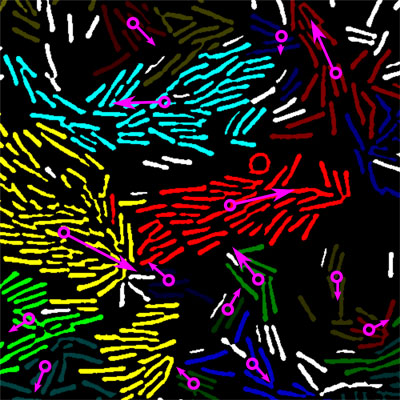Bacteria used to be considered as asocial, unicellular organisms. Over the last few decades it has, however, become clear that bacteria are highly social and engage in a wide range of behaviors that result in a collective fitness advantage. One such behavior is bacterial swarming, which relies on flagella-based swimming motility across wetted surfaces. Swarming allows bacteria to spread across surfaces much more quickly than individual cells, if they were to move on their own. Swarming therefore lets bacterial cells forage more quickly for new nutrient patches.
As bacterial cells grow and swarm across surfaces, they display a range of phenotypic adaptations, and experience significant changes in cell density in their vicinity, which results in dramatically different cellular behaviors as a function of space and time during swarm development. To begin to understand which cell-cell interactions and intracellular behaviors organize the collective behavior inside swarms, the team led by Knut Drescher developed an adaptive microscopy technique, which relies on a closed-loop integration of microscopic image acquisition, live image analysis, and feedback to the motorized microscope control – in other words: an autonomous robotic microscope, whose image acquisition is determined by what the microscope sees unfolding under its lens.

Figure: Groups of Bacillus subtilis cells can move together within a swarm. Each group of co-moving cells is represented by a different color and an average motility direction indicated with a magenta-colored arrow. Copyright: Hannah Jeckel/Knut Drescher.
Based on this adaptive microscope, it was possible to monitor the development of bacterial swarms over five orders of magnitude in length and six orders of magnitude in time at the single-cell level, resulting in gigantic data sets of microscopic, mesoscopic, and macroscopic cellular motility behavior across space and time. To understand whether there were patterns to the bacterial behaviors, a simple machine learning approach was used to directly determine from the data which classes of bacterial (collective) motility behavior the cells performed. This resulted in a dramatic simplification of the gigantic dataset: at any point in space and time during the swarm development, the cells carried out only one of five quantitatively distinct behaviors. This simplification of the swarming process into only five distinct behaviors made it possible to use simulations of cellular motility behaviors for each of the five behavioral states to understand which cell-cell interaction mechanisms are important to account for the collective behavior within each state. Remarkably, all five different collective behavior states could be explained quantitatively when the simulated cells were assumed to only interact mechanically in the simulations – no additional cell-cell interaction was required, which provides a unified understanding of bacterial swarm development. Nevertheless, it is unclear which processes determine the transitions between the collective behavior states, which needs to be investigated in the future.
This work was a collaboration between Knut Drescher’s lab at the Max Planck Institute for Terrestrial Microbiology (Germany) and Jorn Dunkel’s lab at the Massachusetts Institute for Technology (USA), and relied crucially on flexible HFSP funding, to engage in international exchange.


































